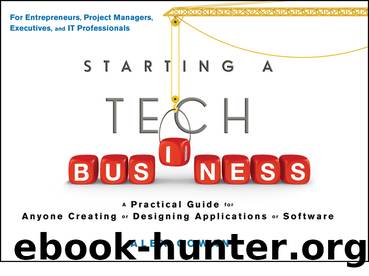Starting a Tech Business by Alex Cowan

Author:Alex Cowan
Language: eng
Format: epub
Publisher: Wiley
Published: 2011-10-04T00:00:00+00:00
Like any simplifying framework, this obscures detail that can be important for certain purposes. But we're not worried about the details here. Instead, we're concerned with getting a basic organizing framework to make sense of our options and trade-offs.
The five layers are:
1. Your Software
2. Helper Packages
3. Foundation Packages
4. Operating System
5. Hardware
If you're creating an add-in or operating on a development platform like Facebook, the iPhone, or Salesforce.com, everything but the software and maybe helper packages is taken care of by the platform and its developer community. In the next few paragraphs, we'll run through an example of how these layers look if you're building and hosting your own web application, which is the plan for Enable Quiz.
Hardware is the physical servers you use. That's consistent these days no matter which technology you chose in the upper layersâmost of it's comparable in price and does the same things. In web applications, there are two popular choices for operating systems: Unix/Linux and Microsoft Server. The things you install on top of a server operating system are called packages, which is the third layer and that's where you actually run your programming language, such as the PHP packages, Java packages, etc. Let's call these foundation packages. Next, you have all the libraries other people have written for your selected technology, which we will call helper packages. These are a big deal because every helper package you can leverage is that much less software code you have to write and maintain yourself. Your Software is the quiz application, for example.
The first question you have to ask yourself is this: How well does our selected technology fit our customers' operating environments? This encompasses the operating system, the foundation packages, and the helper packages you'll require the customers to install and maintain. Your application's compatibility with customers' existing infrastructure will drive your costs and how readily customers adopt your application. For example, if all your customers run Windows Server, then you will want to build your software on .NET, which is Microsoft's development environment. Even though you could run a Java or PHP application on Microsoft Server, it will be more difficult to install and maintain the required packages on Windows Server because in this context Java and PHP are primarily run on Unix and Linux operating systems. Fortunately, Enable Quiz doesn't have to worry about customer environments for software installation and maintenance since it is offering the software as a hosted service. This means that the customers never have to install or upgrade a server to run the software, which is one of the big advantages of pursuing an SaaS model.
The second driver is the availability of development environments and supporting helper packages (libraries), the items in the fourth layer. A development environment is an application that developers use to organize, author, and debug the software they're building. Supporting libraries are existing software you can include in your code instead of writing the applicable code from scratch. A developer's ability to identify and use supporting
Download
This site does not store any files on its server. We only index and link to content provided by other sites. Please contact the content providers to delete copyright contents if any and email us, we'll remove relevant links or contents immediately.
Incentives and Prosocial Behavior by Incentives & Prosocial Behavior(386)
Reframing Difference in Organizational Communication Studies: Research, Pedagogy, and Practice by Dennis K. Mumby (editor)(330)
Financial Markets, Public Policy, and the East Asian Miracle by Financial Markets Public Policy & the East Asian Miracle(295)
The 21 Irrefutable Truths of Trading: A Trader's Guide to Developing a Mind to Win by John Hayden(256)
Handbook of Intercultural Communication and Cooperation (9783666403279) by Unknown(254)
Human Security in Turkey by Alpaslan Özerdem Füsun Özerdem(243)
Human-Computer Interaction by unknow(237)
Fandom Analytics by Michael Lewis(235)
Guns of the World by Unknown(232)
How the World Became Rich: The Historical Origins of Economic Growth by Mark Koyama & Jared Rubin(230)
Inheritance and Wealth Inequality in Britain by Harbury Colin;Hitchins David;(226)
Asset Integrity Management Systems a Complete Guide - 2020 Edition (9780655989844) by Blokdyk Gerardus(214)
Food Security, Affordable Housing, and Poverty by Ahmet Suayb Gundogdu(214)
Creative problem solving for managers by Developing Skills for Decision Making & Innovation(205)
Beyond Positivism, Behaviorism, and Neoinstitutionalism in Economics by Deirdre Nansen McCloskey(202)
The Way of the Wall Street Warrior by Dave Liu & Adam Snyder(201)
The Delusions of Economics by Gilbert Rist;(194)
Diminishing Returns by Mark Blyth(183)
The Inclusion Toolbox by Jennifer A. Kurth & Megan Gross(181)
